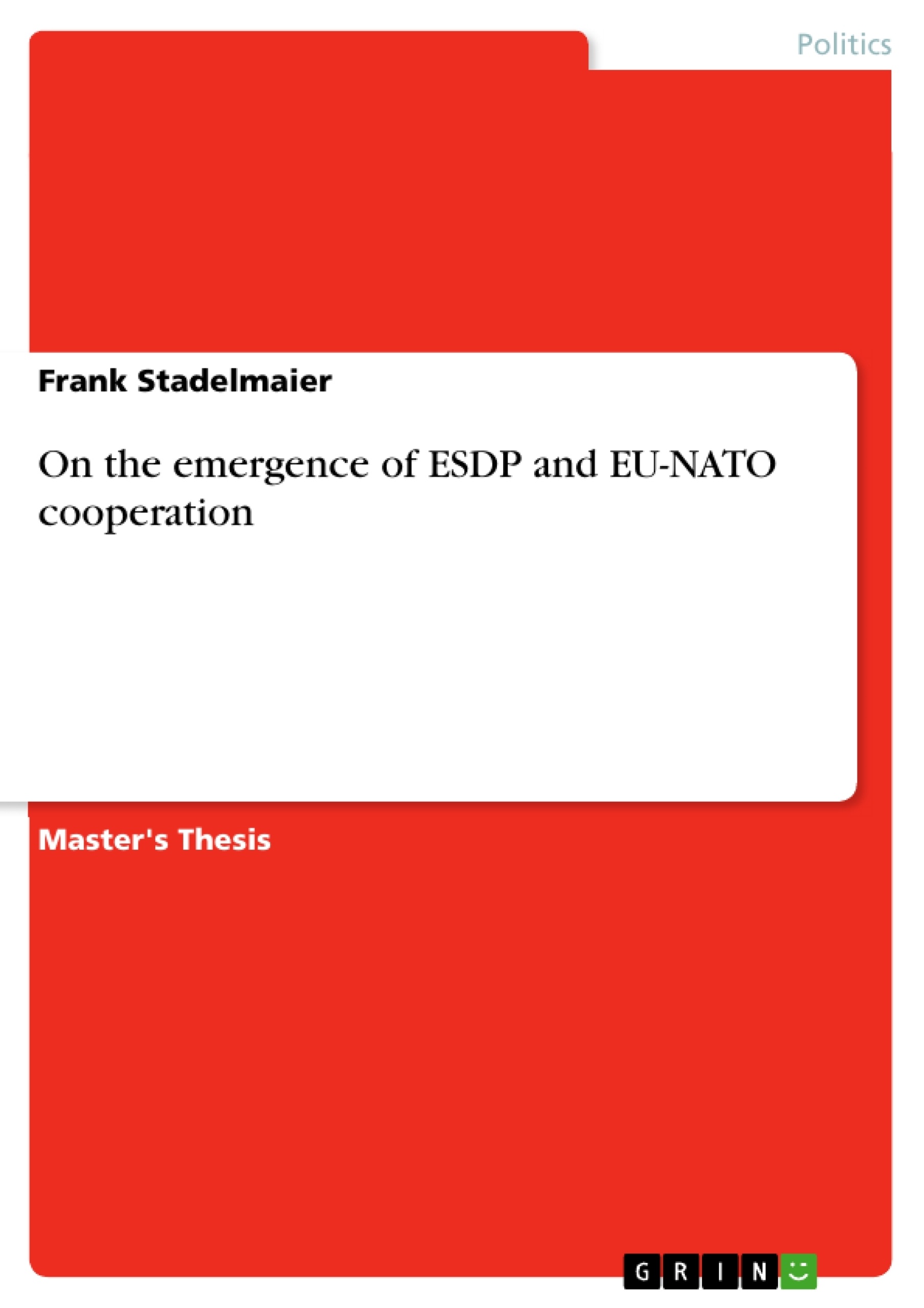This Master thesis in the field of International Relations deals with the emergence of the European Security and Defence Policy (ESDP) and its institutional ties with the North-Atlantic Treaty Organisation (NATO), as defined in the so-called Berlin Plus Agreements. Between European autonomisation and US control through NATO, the thesis explores the conditions of ESDP's formation in the late 1990s and early 2000s. In doing so, it refers to changes in the international system, domestic developments and institutional design; it concludes that ESDP will probably continue on the path of autonomisation, given the circumvention of Berlin Plus and NATO in later missions, and given differing European and US interests in a changing world.
Table of Contents
- Introduction
- Reflections on theory, philosophy of science, and methods
- Puzzlement, causal mechanisms, and inductive process-tracing.
- Constructivism vs. rationalism?
- ESDP as part of European integration
- The new security agenda as a catalyst
- Sovereignty and intervention revisited: changes in international law.
- Building consensus on intervention after the Cold war.
- Kosovo: outside the limits of consensus.
- The current state of consensus: responsibility to protect.
- The EU responds
- Sovereignty and intervention revisited: changes in international law.
- Opening black boxes
- The United Kingdom: governmental and policy change.
- British preference change on Europe...
- The Major government
- The Blair government.
- The mechanism that led to St. Malo
- New causal ideas as road maps.
- The impact of an epistemic community.
- The catalytic effect of the Kosovo crisis
- A mechanism within the mechanism.
- The United States: burden-sharing and leadership.
- The Kosovo war.
- The incoming Bush administration...
- The United Kingdom: governmental and policy change.
- Toward Concordia
- The path of partial Europeanisation.
- Berlin Plus
- The negotiations.
- Implementation.
- Different purposes and perceptions
- Future......
- Problems, perspectives and prospects.
- Conclusion
Objectives and Key Themes
This thesis examines the development of the European Security and Defence Policy (ESDP) and its cooperation with NATO. It aims to understand and explain the emergence of ESDP, focusing on the key moments and mechanisms that drove this transformation. Key themes include:- The role of international law in the context of intervention.
- The evolving relationship between the EU and NATO in security matters.
- The impact of specific crises like Kosovo and the changing dynamics of power in Europe.
- The influence of key actors such as the United Kingdom and the United States in shaping ESDP.
- The development of EU military capacities and the limitations of these capabilities.
Chapter Summaries
- Introduction: This chapter introduces the topic of ESDP and highlights the significance of the St. Malo declaration as a turning point in European security affairs. It discusses the development of ESDP, including its limitations and progress.
- Reflections on theory, philosophy of science, and methods: This chapter delves into the theoretical framework used in the thesis, including the interplay of constructivism and rationalism, and the application of inductive process-tracing methodology.
- The new security agenda as a catalyst: This chapter examines the changing international legal framework for intervention and analyzes the growing consensus on the responsibility to protect. It explores the EU's response to this new security agenda.
- Opening black boxes: This chapter focuses on the mechanisms that led to the St. Malo declaration, analyzing key developments in the United Kingdom and the United States, including the impact of specific crises and the role of epistemic communities.
- Toward Concordia: This chapter explores the path of partial Europeanisation, examining the "Berlin Plus" agreement, its implementation, and its implications for the EU's relationship with NATO. It discusses the future perspectives and challenges for ESDP.
Keywords
This study focuses on key themes like European Security and Defence Policy (ESDP), European integration, EU-NATO cooperation, international law, intervention, responsibility to protect, crisis management, St. Malo declaration, Berlin Plus, and the evolving role of the EU in global security. The analysis draws upon theories of international relations, constructivism, rationalism, and inductive process-tracing, and examines the influence of key actors such as the United Kingdom and the United States.- Arbeit zitieren
- Frank Stadelmaier (Autor:in), 2006, On the emergence of ESDP and EU-NATO cooperation, München, GRIN Verlag, https://www.grin.com/document/72140



